JEEP RENEGADE 2018 Owner handbook (in English)
Manufacturer: JEEP, Model Year: 2018, Model line: RENEGADE, Model: JEEP RENEGADE 2018Pages: 356, PDF Size: 6.11 MB
Page 181 of 356
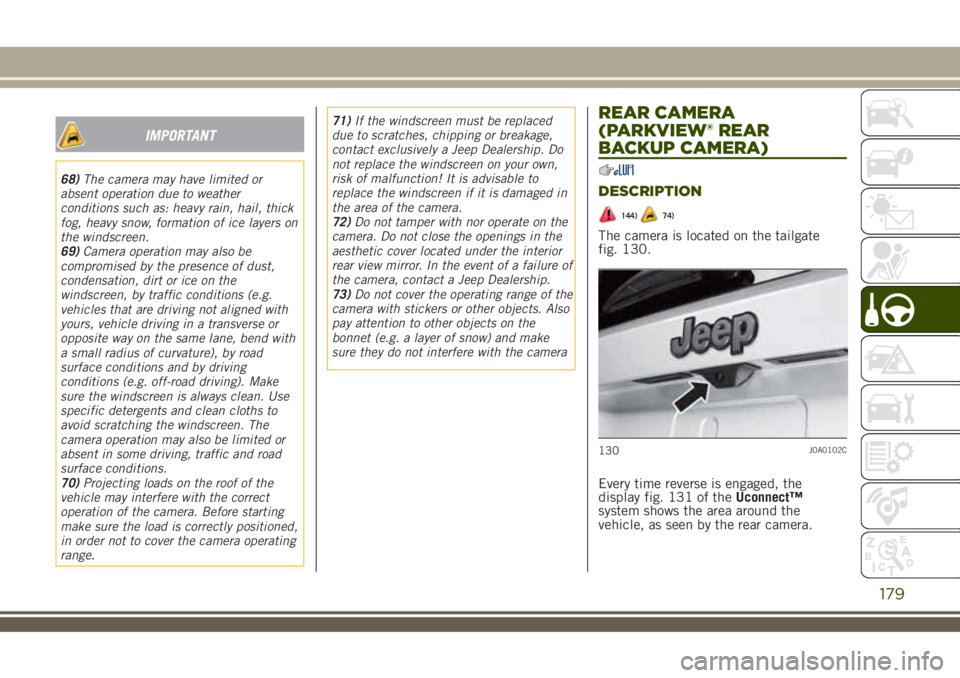
IMPORTANT
68)The camera may have limited or
absent operation due to weather
conditions such as: heavy rain, hail, thick
fog, heavy snow, formation of ice layers on
the windscreen.
69)Camera operation may also be
compromised by the presence of dust,
condensation, dirt or ice on the
windscreen, by traffic conditions (e.g.
vehicles that are driving not aligned with
yours, vehicle driving in a transverse or
opposite way on the same lane, bend with
a small radius of curvature), by road
surface conditions and by driving
conditions (e.g. off-road driving). Make
sure the windscreen is always clean. Use
specific detergents and clean cloths to
avoid scratching the windscreen. The
camera operation may also be limited or
absent in some driving, traffic and road
surface conditions.
70)Projecting loads on the roof of the
vehicle may interfere with the correct
operation of the camera. Before starting
make sure the load is correctly positioned,
in order not to cover the camera operating
range.71)If the windscreen must be replaced
due to scratches, chipping or breakage,
contact exclusively a Jeep Dealership. Do
not replace the windscreen on your own,
risk of malfunction! It is advisable to
replace the windscreen if it is damaged in
the area of the camera.
72)Do not tamper with nor operate on the
camera. Do not close the openings in the
aesthetic cover located under the interior
rear view mirror. In the event of a failure of
the camera, contact a Jeep Dealership.
73)Do not cover the operating range of the
camera with stickers or other objects. Also
pay attention to other objects on the
bonnet (e.g. a layer of snow) and make
sure they do not interfere with the camera
REAR CAMERA
(PARKVIEW® REAR
BACKUP CAMERA)
DESCRIPTION
144)74)
The camera is located on the tailgate
fig. 130.
Every time reverse is engaged, the
display fig. 131 of theUconnect™
system shows the area around the
vehicle, as seen by the rear camera.
130J0A0102C
179
Page 182 of 356
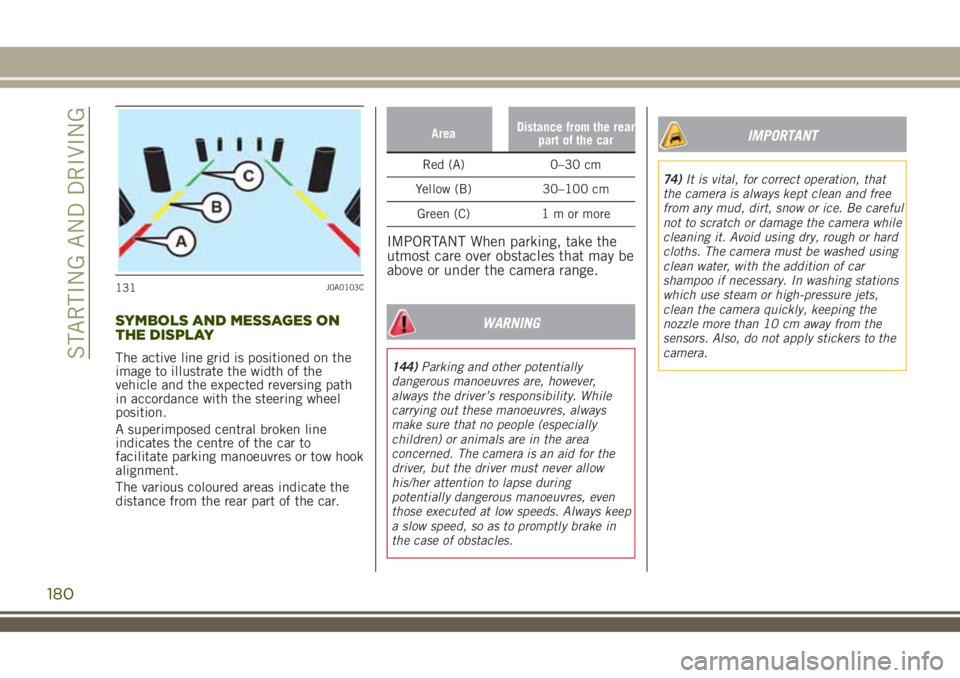
SYMBOLS AND MESSAGES ON
THE DISPLAY
The active line grid is positioned on the
image to illustrate the width of the
vehicle and the expected reversing path
in accordance with the steering wheel
position.
A superimposed central broken line
indicates the centre of the car to
facilitate parking manoeuvres or tow hook
alignment.
The various coloured areas indicate the
distance from the rear part of the car.
AreaDistance from the rear
part of the car
Red (A) 0–30 cm
Yellow (B) 30–100 cm
Green (C) 1 m or more
IMPORTANT When parking, take the
utmost care over obstacles that may be
above or under the camera range.
WARNING
144)Parking and other potentially
dangerous manoeuvres are, however,
always the driver’s responsibility. While
carrying out these manoeuvres, always
make sure that no people (especially
children) or animals are in the area
concerned. The camera is an aid for the
driver, but the driver must never allow
his/her attention to lapse during
potentially dangerous manoeuvres, even
those executed at low speeds. Always keep
a slow speed, so as to promptly brake in
the case of obstacles.
IMPORTANT
74)It is vital, for correct operation, that
the camera is always kept clean and free
from any mud, dirt, snow or ice. Be careful
not to scratch or damage the camera while
cleaning it. Avoid using dry, rough or hard
cloths. The camera must be washed using
clean water, with the addition of car
shampoo if necessary. In washing stations
which use steam or high-pressure jets,
clean the camera quickly, keeping the
nozzle more than 10 cm away from the
sensors. Also, do not apply stickers to the
camera.
131J0A0103C
180
STARTING AND DRIVING
Page 183 of 356
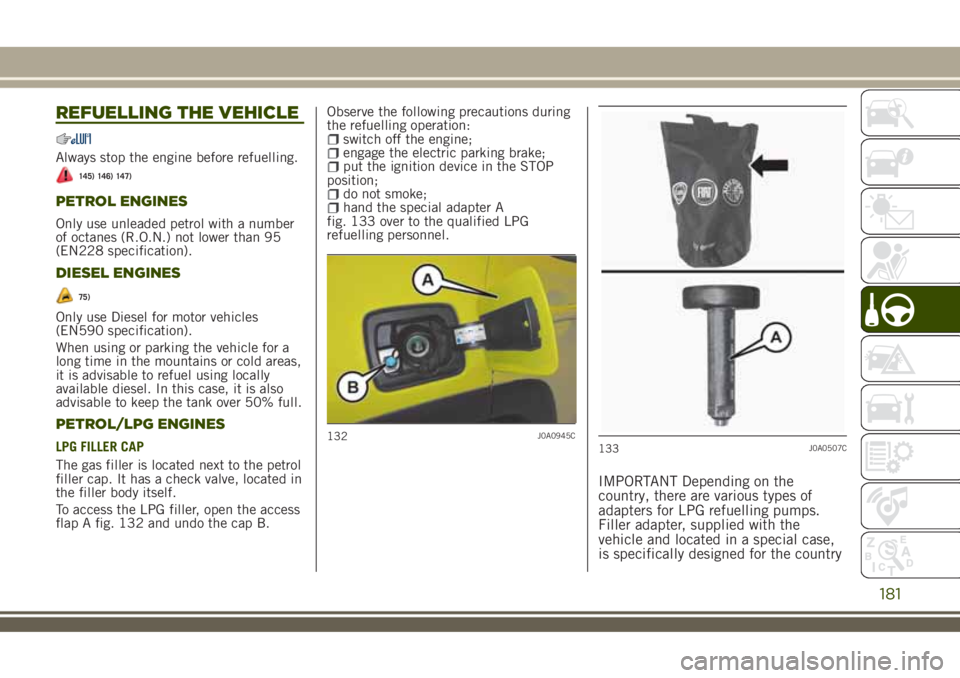
REFUELLING THE VEHICLE
Always stop the engine before refuelling.
145) 146) 147)
PETROL ENGINES
Only use unleaded petrol with a number
of octanes (R.O.N.) not lower than 95
(EN228 specification).
DIESEL ENGINES
75)
Only use Diesel for motor vehicles
(EN590 specification).
When using or parking the vehicle for a
long time in the mountains or cold areas,
it is advisable to refuel using locally
available diesel. In this case, it is also
advisable to keep the tank over 50% full.
PETROL/LPG ENGINES
LPG FILLER CAP
The gas filler is located next to the petrol
filler cap. It has a check valve, located in
the filler body itself.
To access the LPG filler, open the access
flap A fig. 132 and undo the cap B.Observe the following precautions during
the refuelling operation:
switch off the engine;engage the electric parking brake;put the ignition device in the STOP
position;
do not smoke;hand the special adapter A
fig. 133 over to the qualified LPG
refuelling personnel.
IMPORTANT Depending on the
country, there are various types of
adapters for LPG refuelling pumps.
Filler adapter, supplied with the
vehicle and located in a special case,
is specifically designed for the country
132J0A0945C133J0A0507C
181
Page 184 of 356

in which the vehicle is sold. If you are
in a different country, find out what
type of adaptor is used there.
IMPORTANT Before refuelling with
LPG, the qualified personnel must
make sure that the adapter is correctly
screwed onto the filler.
IMPORTANT Look after the LPG
adapter carefully so that it does not get
damaged.
IMPORTANT Only use LPG for motor
vehicles.
IMPORTANT Only use the adapter
supplied with the vehicle as it is
equipped with a dedicated fuel
pre-filter.
REFUELLING PROCEDURE
Opening the flap
To refuel proceed as follows:
open flap A fig. 134, from the point
shown by the arrow;
introduce the dispenser in the filler
and refuel;
then remove the dispenser from the
filler and close flap A.The refuelling procedure described
previously is illustrated on label B
fig. 134, which is applied inside the fuel
flap. The label also indicates the fuel
type (UNLEADED FUEL=petrol,
DIESEL=diesel fuel).Emergency fuel flap opening
Proceed as follows:
working from inside the boot, rotate
hook A fig. 135 anticlockwise, and then
slide it towards the inside of the boot;
pull the cord to unlock the fuel flap;open the fuel flap by pressing on it
(see the previous instructions);
correctly reposition the cord and the
hook in their housing.
134J0A0182C
135J0A0880C
182
STARTING AND DRIVING
(where provided)
Page 185 of 356
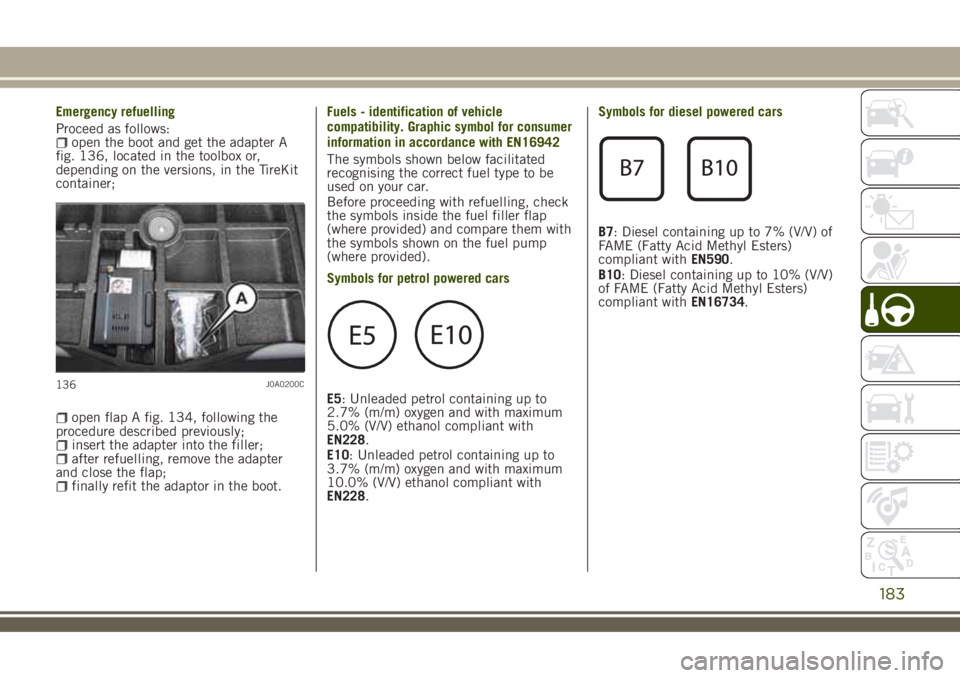
Emergency refuelling
Proceed as follows:
open the boot and get the adapter A
fig. 136, located in the toolbox or,
depending on the versions, in the TireKit
container;
open flap A fig. 134, following the
procedure described previously;
insert the adapter into the filler;after refuelling, remove the adapter
and close the flap;
finally refit the adaptor in the boot.Fuels - identification of vehicle
compatibility. Graphic symbol for consumer
information in accordance with EN16942
The symbols shown below facilitated
recognising the correct fuel type to be
used on your car.
Before proceeding with refuelling, check
the symbols inside the fuel filler flap
(where provided) and compare them with
the symbols shown on the fuel pump
(where provided).
Symbols for petrol powered cars
E5: Unleaded petrol containing up to
2.7% (m/m) oxygen and with maximum
5.0% (V/V) ethanol compliant with
EN228.
E10: Unleaded petrol containing up to
3.7% (m/m) oxygen and with maximum
10.0% (V/V) ethanol compliant with
EN228.Symbols for diesel powered cars
B7: Diesel containing up to 7% (V/V) of
FAME (Fatty Acid Methyl Esters)
compliant withEN590.
B10: Diesel containing up to 10% (V/V)
of FAME (Fatty Acid Methyl Esters)
compliant withEN16734.
136J0A0200C
183
Page 186 of 356
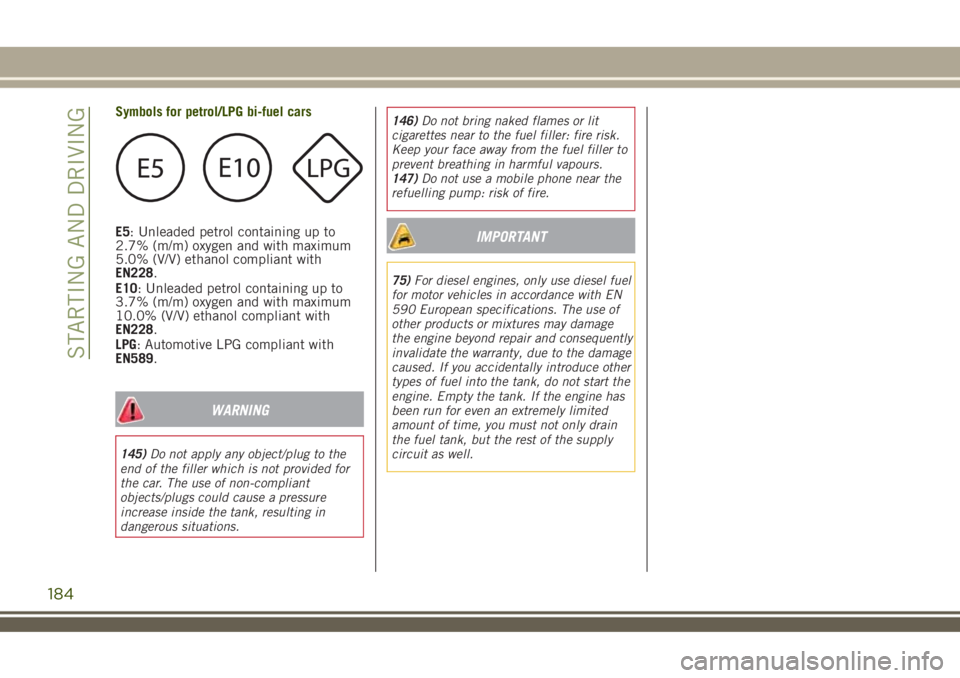
Symbols for petrol/LPG bi-fuel cars
E5: Unleaded petrol containing up to
2.7% (m/m) oxygen and with maximum
5.0% (V/V) ethanol compliant with
EN228.
E10: Unleaded petrol containing up to
3.7% (m/m) oxygen and with maximum
10.0% (V/V) ethanol compliant with
EN228.
LPG: Automotive LPG compliant with
EN589.
WARNING
145)Do not apply any object/plug to the
end of the filler which is not provided for
the car. The use of non-compliant
objects/plugs could cause a pressure
increase inside the tank, resulting in
dangerous situations.146)Do not bring naked flames or lit
cigarettes near to the fuel filler: fire risk.
Keep your face away from the fuel filler to
prevent breathing in harmful vapours.
147)Do not use a mobile phone near the
refuelling pump: risk of fire.
IMPORTANT
75)For diesel engines, only use diesel fuel
for motor vehicles in accordance with EN
590 European specifications. The use of
other products or mixtures may damage
the engine beyond repair and consequently
invalidate the warranty, due to the damage
caused. If you accidentally introduce other
types of fuel into the tank, do not start the
engine. Empty the tank. If the engine has
been run for even an extremely limited
amount of time, you must not only drain
the fuel tank, but the rest of the supply
circuit as well.
184
STARTING AND DRIVING
Page 187 of 356
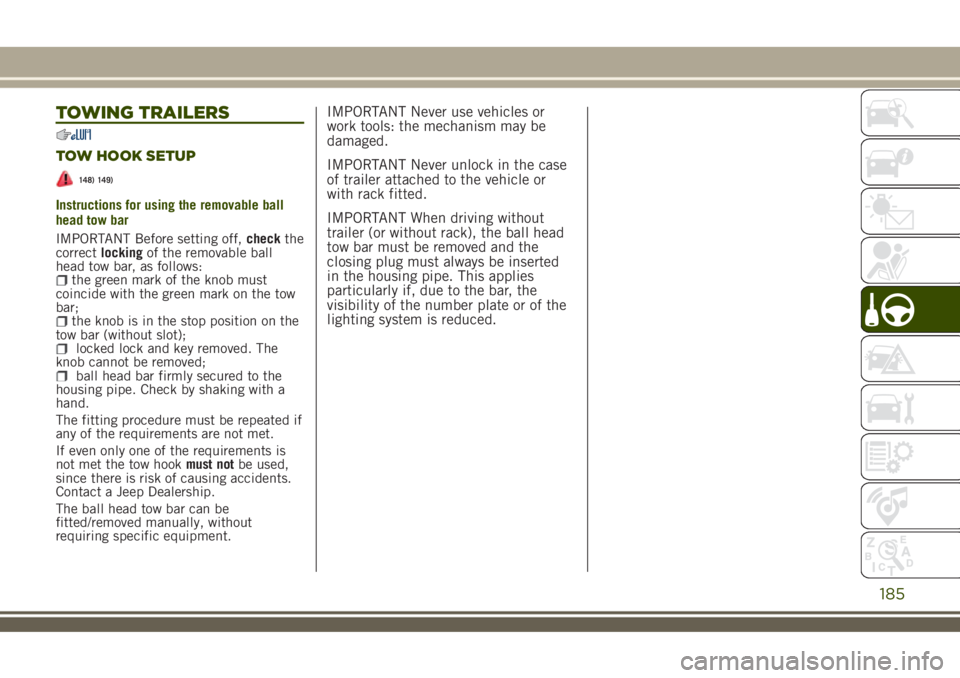
TOWING TRAILERS
TOW HOOK SETUP
148) 149)
Instructions for using the removable ball
head tow bar
IMPORTANT Before setting off,checkthe
correctlockingof the removable ball
head tow bar, as follows:
the green mark of the knob must
coincide with the green mark on the tow
bar;
the knob is in the stop position on the
tow bar (without slot);
locked lock and key removed. The
knob cannot be removed;
ball head bar firmly secured to the
housing pipe. Check by shaking with a
hand.
The fitting procedure must be repeated if
any of the requirements are not met.
If even only one of the requirements is
not met the tow hookmust notbe used,
since there is risk of causing accidents.
Contact a Jeep Dealership.
The ball head tow bar can be
fitted/removed manually, without
requiring specific equipment.
IMPORTANT Never use vehicles or
work tools: the mechanism may be
damaged.
IMPORTANT Never unlock in the case
of trailer attached to the vehicle or
with rack fitted.
IMPORTANT When driving without
trailer (or without rack), the ball head
tow bar must be removed and the
closing plug must always be inserted
in the housing pipe. This applies
particularly if, due to the bar, the
visibility of the number plate or of the
lighting system is reduced.
185
Page 188 of 356
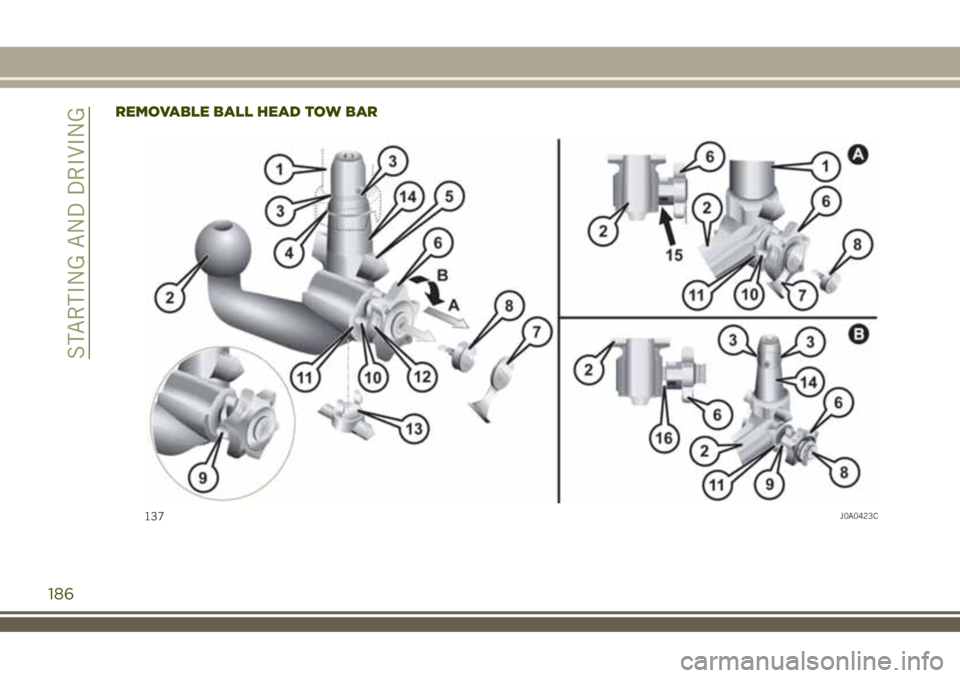
REMOVABLE BALL HEAD TOW BAR
137J0A0423C
186
STARTING AND DRIVING
Page 189 of 356
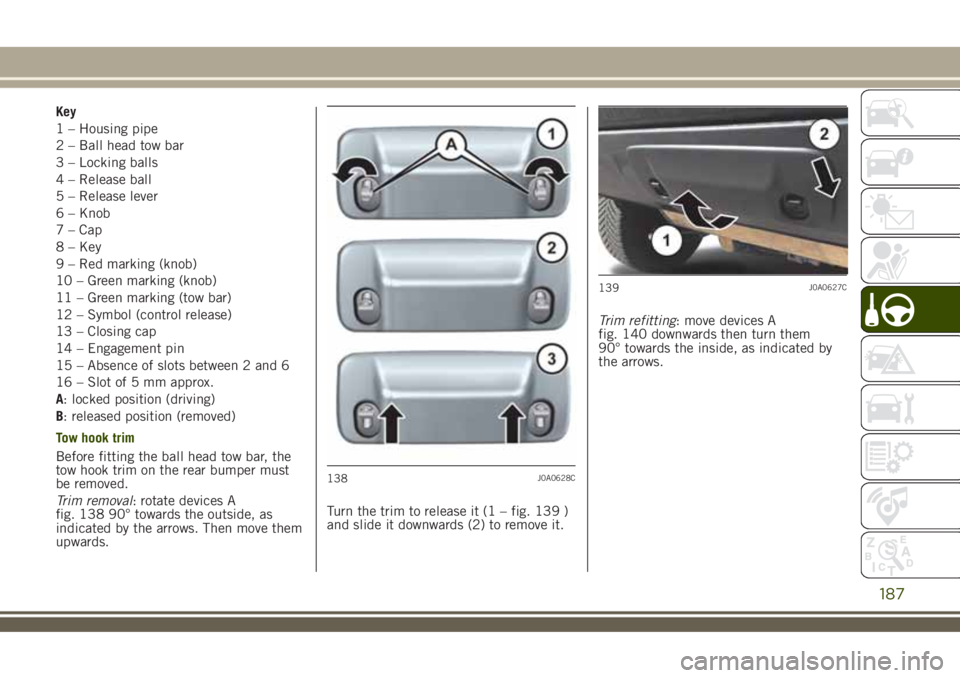
Key
1 – Housing pipe
2 – Ball head tow bar
3 – Locking balls
4 – Release ball
5 – Release lever
6 – Knob
7 – Cap
8 – Key
9 – Red marking (knob)
10 – Green marking (knob)
11 – Green marking (tow bar)
12 – Symbol (control release)
13 – Closing cap
14 – Engagement pin
15 – Absence of slots between 2 and 6
16 – Slot of 5 mm approx.
A: locked position (driving)
B: released position (removed)
Tow hook trim
Before fitting the ball head tow bar, the
tow hook trim on the rear bumper must
be removed.
Trim removal: rotate devices A
fig. 138 90° towards the outside, as
indicated by the arrows. Then move them
upwards.Turn the trim to release it (1 – fig. 139 )
and slide it downwards (2) to remove it.Trim refitting: move devices A
fig. 140 downwards then turn them
90° towards the inside, as indicated by
the arrows.
138J0A0628C
139J0A0627C
187
Page 190 of 356
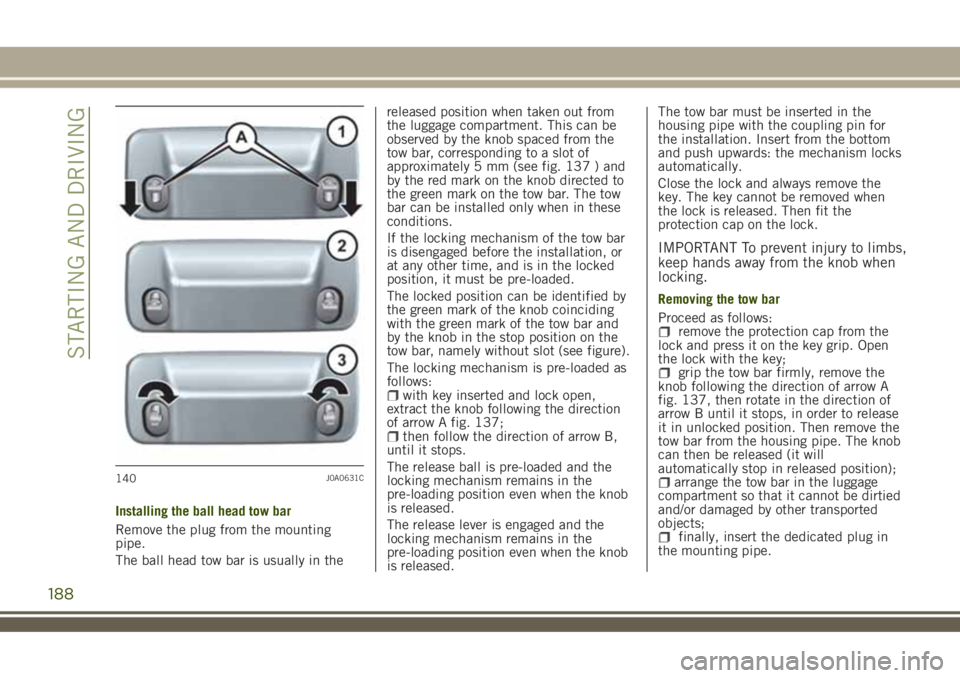
Installing the ball head tow bar
Remove the plug from the mounting
pipe.
The ball head tow bar is usually in thereleased position when taken out from
the luggage compartment. This can be
observed by the knob spaced from the
tow bar, corresponding to a slot of
approximately 5 mm (see fig. 137 ) and
by the red mark on the knob directed to
the green mark on the tow bar. The tow
bar can be installed only when in these
conditions.
If the locking mechanism of the tow bar
is disengaged before the installation, or
at any other time, and is in the locked
position, it must be pre-loaded.
The locked position can be identified by
the green mark of the knob coinciding
with the green mark of the tow bar and
by the knob in the stop position on the
tow bar, namely without slot (see figure).
The locking mechanism is pre-loaded as
follows:
with key inserted and lock open,
extract the knob following the direction
of arrow A fig. 137;
then follow the direction of arrow B,
until it stops.
The release ball is pre-loaded and the
locking mechanism remains in the
pre-loading position even when the knob
is released.
The release lever is engaged and the
locking mechanism remains in the
pre-loading position even when the knob
is released.The tow bar must be inserted in the
housing pipe with the coupling pin for
the installation. Insert from the bottom
and push upwards: the mechanism locks
automatically.
Close the lock and always remove the
key. The key cannot be removed when
the lock is released. Then fit the
protection cap on the lock.
IMPORTANT To prevent injury to limbs,
keep hands away from the knob when
locking.
Removing the tow bar
Proceed as follows:
remove the protection cap from the
lock and press it on the key grip. Open
the lock with the key;
grip the tow bar firmly, remove the
knob following the direction of arrow A
fig. 137, then rotate in the direction of
arrow B until it stops, in order to release
it in unlocked position. Then remove the
tow bar from the housing pipe. The knob
can then be released (it will
automatically stop in released position);
arrange the tow bar in the luggage
compartment so that it cannot be dirtied
and/or damaged by other transported
objects;
finally, insert the dedicated plug in
the mounting pipe.
140J0A0631C
188
STARTING AND DRIVING